Prewar Alfa Romeos offer pure elegance, exceptional performance
Alfa Romeos have always been cars of commerce, sculpture, and competition. Before the First World War, it was the futuristic Torpedo—a streamlined, aerodynamic Series A 40/60 racer capable of 86 mph. A smooth, aero-friendly teardrop body by Carrozzeria Castagna set this Alfa apart visually from everything else.
Alfa made trucks and buses, but it was always the sporting cars and the racers that were its signature products. The cars from Lombardy would be the foundation of some of the most breathtaking coachwork of the 20th century.
Alfas were winners even before they were called Alfa Romeos. A.L.F.A. was the acronym for Anonima Lombarda Fabbrica di Automobili. The company’s first race was the 1911 Targa Florio and its first victory came later that year. The firm was acquired by Nicola Romeo in 1915 and from that moment the cars became known as Alfa Romeos.
The first victory came in 1920 when Giuseppe Campari raced his 82-hp Alfa Romeo 40/60 to victory on the Mugello Circuit near Florence. A second-place finish in the 1920 Targa Florio by a young aspiring racer named Enzo Ferrari driving a 4.1-liter Model 20/30 furthered Alfa Romeo’s growing competition résumé. Alfa’s first win through the Sicilian hills in the fabled Targa Florio came in 1923, when a 3.0-liter straight-six RLTF driven by Ugo Sivocci won the harrowing race at an average speed of 37 mph.
The First Grand Prix Champions
The hiring of designer Vittorio Jano in 1924 opened the floodgates of Alfa competition success. His 2.0-liter twin-cam straight-eight won the first time out in Europe’s most important and richest Grand Prix, the 1924 Grand Prix de l’ACF—the French Grand Prix—when Giuseppe Campari raced the new and revolutionary Alfa Romeo P2 to its first GP win in a fierce seven-hour-and-five-minute hammering around the 14.38-mile Lyon road course. In 1925, the mighty P2 won the Italian GP at Monza in the fastest grand prix of the season. Good enough for the firm to redesign its badge to crown Il Biscione (Alfa and Milan’s crowned serpent) with a gold wreath, celebrating its first Grand Prix World Championship.

Jano’s sports-car designs were as successful as his grand prix racers. Alfa’s 1500-cc and 1750-cc sports cars began their run of successes when Enzo Ferrari won the Circuit of Modena race in a normally aspirated 6C 1500. The first Mille Miglia victory came in 1928 with Campari’s 6C 1500. In just one extraordinary 24-hour period, the 1750 of 1929 won the Belgian Grand Prix, the 12-hour race at Brooklands, and the Mille Miglia. Maestro Tazio Nuvolari scored his first of two Alfa-powered 1000-mile victories with a 1750S in 1930. It was an avalanche in red: Alfa 6C 1750 GSs took first, second, third, fourth, eighth, ninth, and tenth place. Then Nuvolari followed up with another 6C 1750 victory in the Royal Automobile Club’s Tourist Trophy.
Alfa Owns Italy’s Open Roads
Alfa practically owned the Mille Miglia in the 1930s. Jano’s 8C 2300 won in 1932, heading an Alfa 1-2-3-4-5-6-7 sweep. Achille Varzi—Nuvolari’s great rival—took the ’34 Mille Miglia with an 8C 2600 Monza leading a four 8C Alfa train. A factory-modified, two-place Tipo B Grand Prix car won the race for Alfa in 1935, with a fleet of 8C 2600 and 2300s taking second, third, fourth, fifth, sixth, eighth, ninth, and tenth place.
But the Great Depression soon caught up. Alfa was nationalized by the IRI (Institute for the Reconstruction of Italian Industry) in 1933 and competition responsibilities went to the newly formed Scuderia Ferrari. Alfa persevered with elderly Monzas as the Type B was withdrawn from GP duty. Scuderia Ferrari’s prancing horse replaced the signature Quadrifoglio insignia. But Portello and the decision-makers in Rome relented in August—just before the traditional date of the Italian GP—and the Alfa Type Bs were returned to competition. Luigi Fagioli scored first in the all-important Italian GP on September 10. Then Louis Chiron won at Brno in the Czech GP and at Lasarte in the Spanish GP.
Elegant Underdog & Sheer Genius

The new Tipo B swept the 1932 Grand Prix season, winning the Grands Prix of Monaco, Italy, France, and Germany. There were two more Monaco GP wins that decade, but the race from the Tipo B epoch that is still talked about is the 1935 German Grand Prix on the mighty 14-mile Nürburgring.
By then Alfa’s Tipo B was already in its fourth season. To complicate matters further, a new government in Germany had decided that motorsports success was a fine tool for propaganda intended to restore Germany’s post-WWI reputation.
The new German chancellor opened the state wallet and instructed Mercedes-Benz and Auto Union to dominate grand prix racing. Which they did, winning at Monaco, France, and Belgium. All was going according to plan until late July, when the grand prix circus moved to Germany and the most complex and demanding of the GP circuits: the mighty Nordschleife, or Nürburgring.
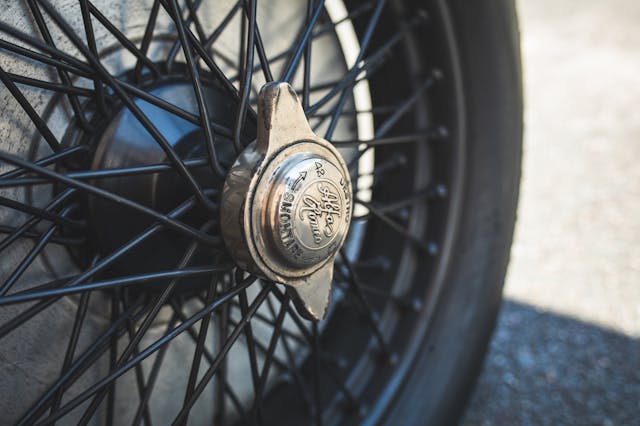
In a display of virtuosity that still astonishes nearly nine decades later, Tazio Nuvolari defeated the new silver cars of Germany with his aging Alfa Tipo B. He lost nearly two minutes to the Germans while waiting for new tires and fuel. He screamed instructions and encouragements and threatened mechanics with a hammer. What followed was a ruthless and manic drive at the thin edges of physics, metallurgy, and human reflexes. Nuvolari cleaved huge chunks of time from the silver cars in front, reducing the leader’s gap by as much as 15 seconds per lap.
When they placed the winner’s wreath around Nuvolari’s grimy neck, the stunned German GP organizers discovered they had no copy of the Italian national anthem to honor the winner. That’s when Nuvolari produced a 78-rpm phonograph record of the Italian national anthem, something he carried to all his races! Just in case.
Bimotore—a Radical Alfa Romeo as the First Ferrari?
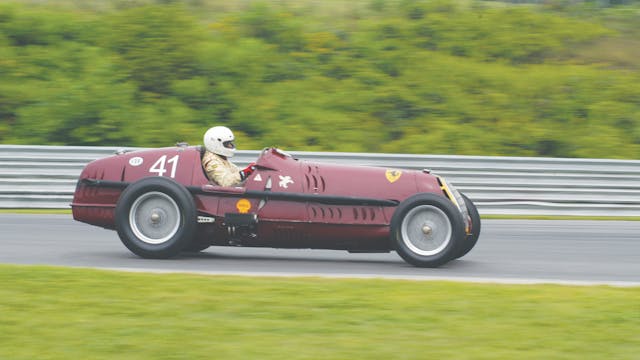
The 1935 season also saw the creation of a pair of Alfa racers that some with a long view of history often consider the first Ferraris … even though they wore the Alfa champion’s wreath around their Il Biscione emblem.
Enzo Ferrari and company conceived a pair of twin-engine Bimotore Alfas for speed runs, the high-speed Avus Races in Berlin, and the Race of Millions on the lightning-fast Tripoli circuit of North Africa. Some very novel engineering was involved, and one of the front-and-rear eight-cylinder engine beasts was sent to the Autostrada between Brescia and Bergamo to see if the innovators at Scuderia Ferrari were indeed onto something.
The most enthusiastic driver for this exercise was, not surprisingly, the gifted Tazio Nuvolari. His first official two-kilometer run was calculated at 175 mph. But Nuvolari reported calmly that he had reached 5300 rpm. There was silence. That number equaled 200 mph on Alfa’s gear charts. That’s when the great racer said the Bimotore “drives like a Lancia Aprilia (Italy’s best small car) and that 5600 rpm should also be possible.” Another quick look at the Bimotore’s gear charts raised eyebrows again: 5600 rpm equaled 210 mph.

Alfa Comes to America
Great Depression or not, the Vanderbilt Cup of the early 20th century was revived in 1936 on a Long Island road course, designed by 1908 Vanderbilt Cup winner George Robertson. Alfa’s V-12 GP car would carry the greatest racer on the European continent to Vanderbilt victory.
Nuvolari raced his Scuderia Ferrari–entered Alfa 12C-36 with a 4.1-liter V-12, four-wheel independent suspension, and a five-speed transmission. It was capable of 170 mph. But on Roosevelt Raceway’s twisty course such speeds were impossible, and it wasn’t a fair fight against the American dirt trackers and Indy cars. One commentator wrote: “The Vanderbilt Cup was over when Tazio Nuvolari stepped off the boat.” It took him just over four hours to add Alfa’s name to American motorsport history.
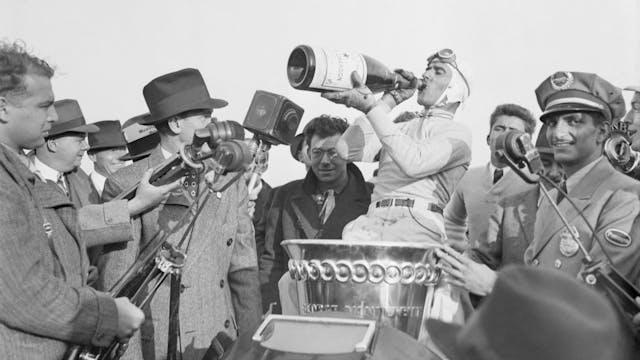
Performance Precedent
Nicola Romeo’s cars occupy the spot of “first” in many categories: They were the first vehicles that many of us would call “Italian exotics.” They were the first cars to win the first World Championship (1925), the first to wear Scuderia Ferrari’s Cavallino Rampante, and, in 1931, the first Italian cars to win the 24 Hours of Le Mans. With record-setting style, the cars were also the first Le Mans winners to cover more than 3000 kilometers and the first to win all three Le Mans special victories: the overall distance, the Coupe Biennale, and the Index of Performance. Alfa won Le Mans four times in a row, before the world descended into the maw of World War II.
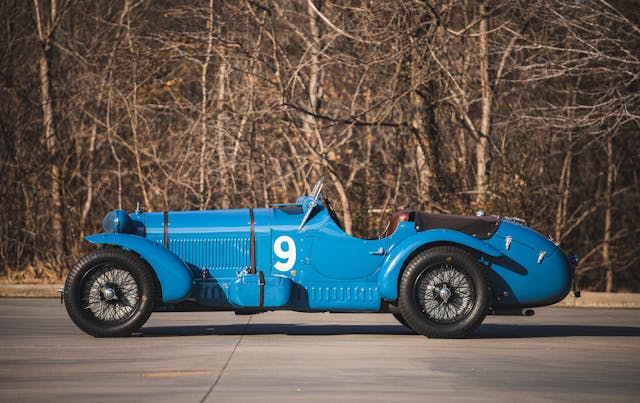
Alfa should have won Le Mans again in 1938 with the Speciale Le Mans coupe by Carrozzeria Touring. Its superleggera-bodied 8C 2900 B aerodynamic coupe was raced by double Le Mans winner Raymond Sommer and Alfa works GP racer Clemente Biondetti that June weekend. The Italian press called the coupe “Soffio di Satana” (devil’s breath). It crushed all comers for the first 20 hours.
The designers who created the “devil’s breath” understood that Le Mans was a different creature. Its geography and distance dictated its own demands; the Italians created, designed, and built accordingly, proving they had their sums right. That is, until just after noon on Sunday, June 19, 1938.
A blown tire slashed the aluminum of the Speciale Le Mans 2900 B. There was also engine damage. Sommer managed to keep the 8C on the road, getting back to the pits where the aluminum was repaired. Biondetti took over and returned to the race, still with more than a 100-mile lead.
The 8C coupe sputtered on; Biondetti made a series of diagnostic pits stops. He was finally stopped for good on the Mulsanne Straight, miles from help; he parked the 8C at the edge of the straight. Based on distance, it took a remarkable fourth overall.
The First Supercar

The 8C 2900 B had long legs. When the Mille Miglia returned to the international calendar in June 1947, it welcomed the ex-1937 Paris Salon 8C 2900 B show car of entrant Emilio Romano and Biondetti. A decade after its creation, it took Alfa’s 11th and final overall victory in the fabled 1000-mile tour of Italy. A year later, Frank Griswold’s 8C 2900 B made American road-racing history, winning the inaugural Watkins Glen GP.
Still Winning Eight Decades On

The 8C 2900 B was the last and the most spectacular of the prewar Alfas. At Pebble Beach, it has won Best of Show four times. In 2000, a 1938 8C 2900 B won Best of Show at The Amelia. In 2017, Amelia’s Best of Show Concours de Sport went to an 8C 2900 B Touring Spider. Amelia Concours chairman emeritus Bill Warner summed up the power and presence of Alfa Romeo’s prewar grand tourers: “The 2900 B is all but unbeatable on the concours lawn. It’s practically a guaranteed winner … unless there’s another prewar Alfa on the field.”
Prewar Alfa Romeos is one of 20 classes to be featured at the 2023 Greenwich Concours d’Elegance, on June 2-4, 2023. Download the 2023 Greenwich Concours d’Elegance event program to learn more about Sunday’s other featured classes, Saturday’s Concours de Sport, our judges, sponsors, non-profit partners, 2022 winners and more!
***
Check out the Hagerty Media homepage so you don’t miss a single story, or better yet, bookmark it. To get our best stories delivered right to your inbox, subscribe to our newsletters.
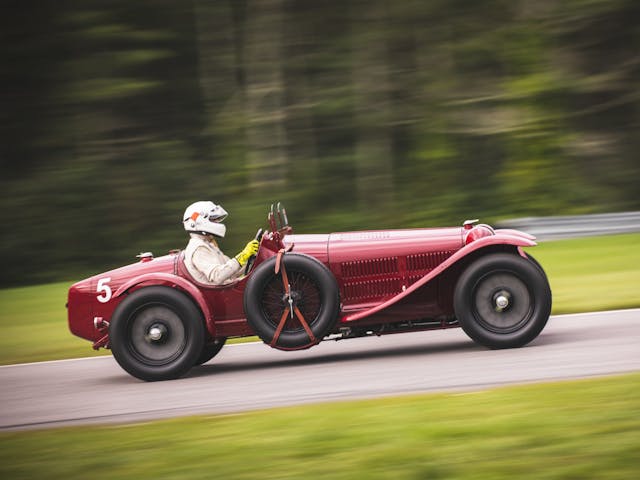




Great article! Lots of interesting info.
Here on Long Island, the Vanderbilt Motor Parkway is still a much-used roadway.
It’s a very pretty, mostly residential road, with many hills and curves.
So wonderful to introduce the world of the glorious history of Alfa racing history!
So so thank you! Wonderful read.